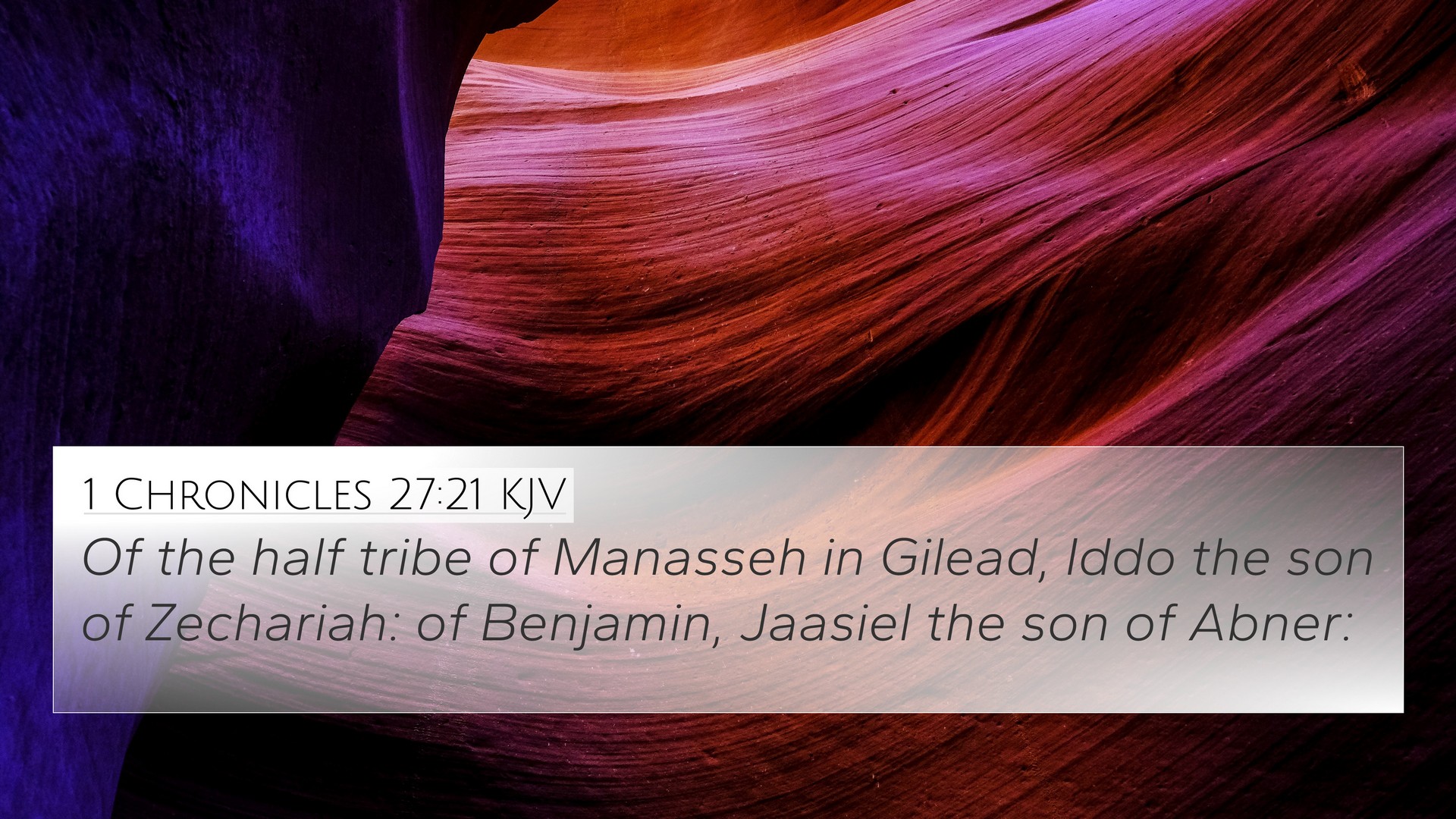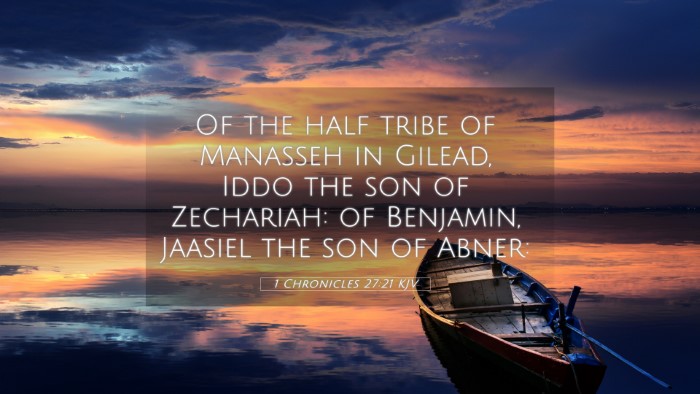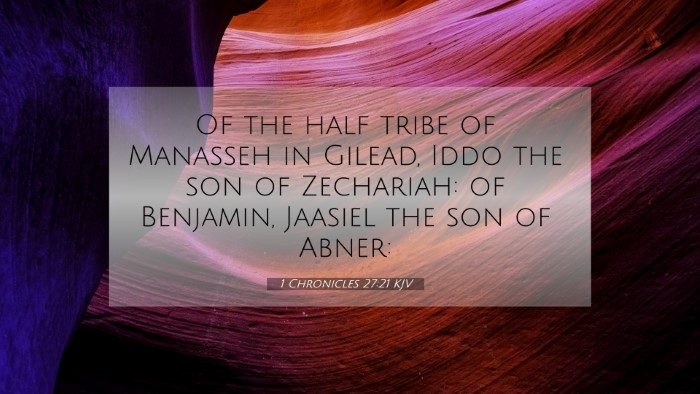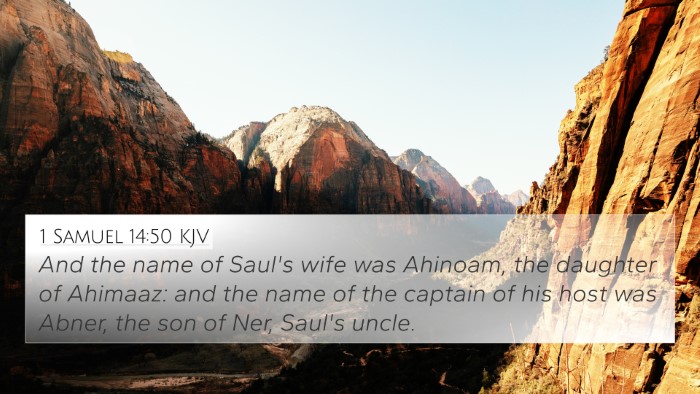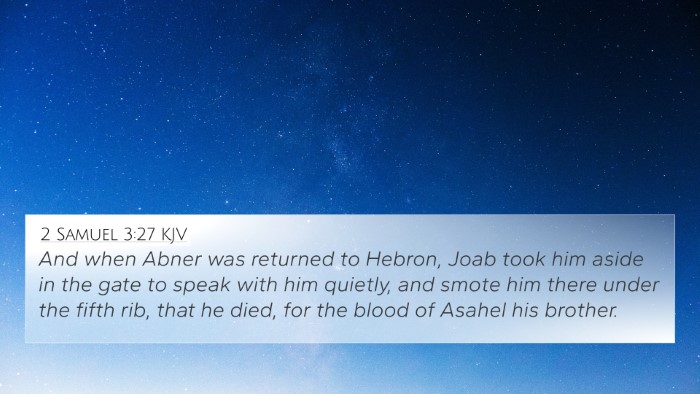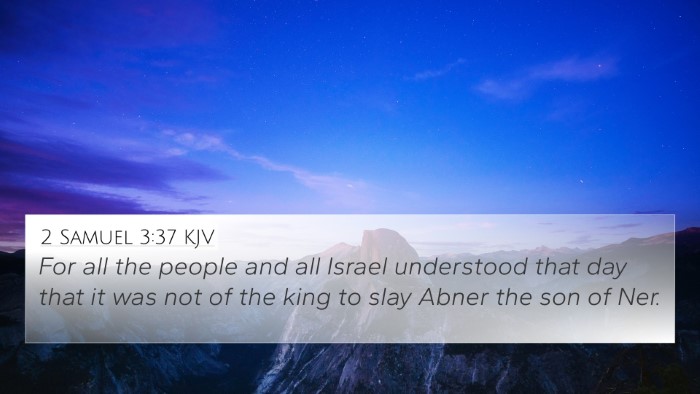Understanding 1 Chronicles 27:21
1 Chronicles 27:21 states: "The fourteenth captain for the fourteenth month was Ahijah the Netophathite, of the sons of Ebenezer: and in his course were twenty and four thousand." This verse is part of a larger section that describes the organization of David's military divisions. It identifies Ahijah as one of the commanders responsible for a specific month of service.
Context and Background
The context of 1 Chronicles 27 presents David's reign over Israel and highlights his administrative and military structures. David’s oversight includes not only armies but an entire nation where each tribe and family played a crucial role in sustaining the kingdom. The organization of military captains, such as Ahijah, exemplifies David's strategic governance.
Thematic Insights
Several themes can be derived from this verse:
- Leadership and Responsibility: The appointment of captains indicates a defined structure of authority and responsibility in David's army.
- Divine Order: The systematic organization reflects the orderliness of God's plans for His people.
- Service and Duty: Each captain serving for specific months illustrates the duty and commitment expected from leaders.
Commentary Insights
Insights from public domain commentaries provide deeper understanding:
- Matthew Henry: Henry emphasizes the importance of organized government in civil and military affairs. He notes that David’s leadership was marked by wisdom and prudence in appointing leaders.
- Adam Clarke: Clarke highlights the geographical significance of Ahijah's lineage, noting that the Netophathites were from a town near Bethlehem, reflecting the historical context of David’s reign. He suggests that such specifics reflect God's providence in the unfolding history of His people.
- Albert Barnes: Barnes discusses the military divisions as a means of both protection and order in the kingdom, underlining the necessity for such structuring in a time of potential conflict.
Cross-References
1 Chronicles 27:21 connects thematically and contextually with several other Bible verses:
- 1 Chronicles 28:1: Discusses David assembling the leaders of Israel for the transfer and establishment of wisdom regarding the temple.
- 2 Samuel 23:8-39: Elaborates on David’s mighty men, showcasing the importance of military leaders during his reign.
- 1 Chronicles 12:1-22: Details the various leaders who came to David from different tribes, highlighting unity under his rule.
- 2 Chronicles 17:14-19: Describes the appointed officials during Jehoshaphat's reign, paralleling the structured leadership in David's time.
- Exodus 18:21: Discusses Moses appointing leaders to judge the people, establishing a precedent for organized leadership.
- Nehemiah 11:1-2: Details how leaders lived in Jerusalem and the structure of governance in a restoration period.
- Joshua 4:4-7: Represents the importance of memorials and remembrance in the context of divine order and structure.
Inter-Biblical Dialogue and Comparative Bible Analysis
This verse serves as a crucial point in understanding the overall theme of leadership and divine order in the Bible, allowing for comparative analysis with leadership structures in both the Old and New Testaments. For example, the leadership of Jesus and His apostles can be contrasted with David's appointed leaders. This comparative study can elucidate the evolution of spiritual leadership from the Old Testament to the New Testament.
Similarities with New Testament Teaching
Notable similarities can be drawn between David's organization of leaders and Paul's instruction regarding church leadership. In 1 Timothy 3, Paul outlines qualifications for overseers, paralleling David's care in appointing trusted leaders within his ranks.
Tools for Bible Cross-Referencing
Utilizing a Bible concordance or a cross-reference guide can greatly enhance one’s understanding of connections between biblical texts. Here are some suggested tools:
- Digital Bible Studies that include cross-reference features.
- Hardcopy Bible Concordances that organize scripture by themes and keywords.
- Online resources that allow users to search for related verses efficiently.
Conclusion
1 Chronicles 27:21 emphasizes the significance of structured leadership within God's chosen people. By cross-referencing numerous scriptures, one can appreciate the interconnectedness of biblical themes that highlight God's providence, the importance of leadership, and the overarching narrative of unity and order throughout the Bible. Engaging in detailed cross-reference studies can enrich one's understanding of biblical texts and their applications in faith.
